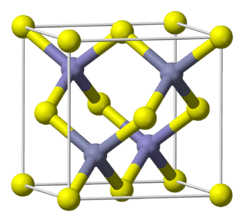Gallium antimonide
 | |
| Names | |
|---|---|
| IUPAC name
Gallium(III) antimonide | |
| Other names
Gallium antimonide | |
| Identifiers | |
| 12064-03-8 | |
| 3D model (Jmol) | Interactive image |
| ChemSpider | 3436915 |
| ECHA InfoCard | 100.031.859 |
| PubChem | 4227894 |
| |
| |
| Properties | |
| GaSb | |
| Molar mass | 191.483 g/mol |
| Density | 5.614 g/cm3 |
| Melting point | 712 °C (1,314 °F; 985 K) |
| insoluble | |
| Band gap | 0.726 eV (300 K) |
| Electron mobility | 3000 cm2/(V*s) (300 K) |
| Thermal conductivity | 0.32 W/(cm*K) (300 K) |
| Refractive index (nD) |
3.8 |
| Structure | |
| Sphalerite, cF8 | |
| F-43m, No. 216 | |
| Hazards | |
| NFPA 704 | |
| Flash point | Non-flammable |
| Except where otherwise noted, data are given for materials in their standard state (at 25 °C [77 °F], 100 kPa). | |
| | |
| Infobox references | |
Gallium antimonide (GaSb) is a semiconducting compound of gallium and antimony of the III-V family. It has a lattice constant of about 0.61 nm.
History
The intermetallic compound GaSb was first prepared in 1926 by Victor Goldschmidt, who directly combined the elements under an inert gas atmosphere and reported on GaSb's lattice constant, which has since been revised. Goldschmidt also synthesized gallium phosphide and gallium arsenide.[1] The Ga-Sb phase equilibria was investigated in 1955 by Koster[2] and by Greenfield.[3]
Applications
GaSb can be used for Infrared detectors, infrared LEDs and lasers and transistors, and thermophotovoltaic systems.
See also
References
External links
- properties listed at NSM, Ioffe Institute.
- National Compound Semiconductor Roadmap at the Office of Naval Research
This article is issued from Wikipedia - version of the 8/31/2016. The text is available under the Creative Commons Attribution/Share Alike but additional terms may apply for the media files.
